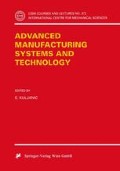Abstract
general, abstract model is proposed for a production system consisting of a flow line, made of several machines, which can produce different products. Based on this model, a formal definition of push and pull concepts is provided. Different operating conditions are considered, and an abstract characterization of the set of all fesible production plans is proposed. Some of its general properties are then investigated: in particular, a minimum wip production plan is characterized, apt to tackle bounded perturbations of processing times.
Access this chapter
Tax calculation will be finalised at checkout
Purchases are for personal use only
Preview
Unable to display preview. Download preview PDF.
References
Bitran, G.R., and Chang, L., “A mathematical programming approach to a deterministic Ka.nban system,” Management Science 33, 1987, 427–441.
Blanchini, F., Rinaldi, F., and Ukovich, W., “A network design problem for a distribution system with uncertain demands,” SIAM Journal on Optimization,accepted for publication.
Karmarkar, U.S., “Kanban systems,” Paper Series N. QM8612, Center for Manufacturing and Operation Management. The Graduate School of Management, University of Rochester, Rochester, N.Y., 1986.
Kimura, O., and Terada, H., “Design and analysis of pull systems: A method of multi—stage production control,” International Journal of Production Research 19, 1981, 241–253.
Krajewski, L..1., King, B.F., Ritzman, L.P., and Wong, D.S., “Kanban, MRP, and shaping the manufacturing environment,” Management Science 33, 1987, 39–57.
Lucertini, M., Nicolò, F., Ukovich, W., and Villa, A., “Models for Flow Management”, International Journal of Operations and Quantitative Management,to be published.
Spearman, M.L., and Zazanis, M.A., “Push and pull production systems: Issues and comparisons,” Operations Research 40, 1990, 521–532.
Villa, A., Fassino, B., and Rossetto, S., “Buffer size planning versus transfer line efficiency,” Journal of Engineering for Industry 108, 1986, 105–112.
Author information
Authors and Affiliations
Editor information
Editors and Affiliations
Rights and permissions
Copyright information
© 1996 Springer-Verlag Wien
About this chapter
Cite this chapter
Lucertini, M., Nicolò, F., Ukovich, W., Villa, A. (1996). A Family of Discrete Event Models for Flow Line Production. In: Kuljanic, E. (eds) Advanced Manufacturing Systems and Technology. International Centre for Mechanical Sciences, vol 372. Springer, Vienna. https://doi.org/10.1007/978-3-7091-2678-3_36
Download citation
DOI: https://doi.org/10.1007/978-3-7091-2678-3_36
Publisher Name: Springer, Vienna
Print ISBN: 978-3-211-82808-3
Online ISBN: 978-3-7091-2678-3
eBook Packages: Springer Book Archive

